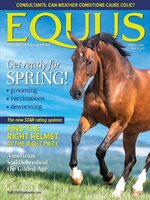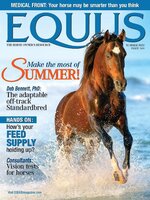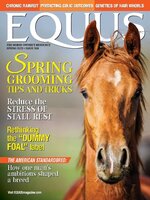EQUUS provides the latest information from the world's top veterinarians, equine researchers, riders and trainers on understanding and influencing equine behavior, recognizing the warning signs of illness and disease, and solving riding and training problems.
EQUUS
LETTERS
DIGESTION-FRIENDLY TRANSPORT
MOVABLE PARTS
POP QUIZ
WINTER GEAR PREP
READY-MADE BLANKET RACK
THE EQUINE DISCOMFORT ETHOGRAM: A MAJOR ADVANCE
FISH-SKIN DRESSING SHOWS PROMISE FOR TREATING EQUINE WOUNDS
HOW DO HORSES SEE THEMSELVES?
THE ROOM REQUIRED FOR HERD HARMONY
HANGING IN THE BALANCE • After a freak accident leaves a young gelding dangling in his stall by a single fetlock, his survival and recovery are far from assured.
PART 1: A TERRIFYING SIGHT • My beautiful young gelding was hanging in his stall by his hind leg. Was he broken beyond healing?
PART 2: HEALING BEGINS • In the immediate aftermath of Arteiro’s accident, our main task was dealing with the long-term consequences of his injuries.
PART 3: DETERMINATION PAYS OFF • A year after his accident, my young horse once again has a promising future.
Cupid: A Love Story • The best Valentine’s Day surprise I ever received was the opportunity to help a little gelding with sparkling eyes and the heart of a fighter.
HEALTHY FROG, HAPPY HORSE • The triangular pad of tissue at the center of the equine hoof has many functions and often signals when something is amiss.
“TWO-FRONT” THRUSH TREATMENT
A Leg Up • At a cutting-edge pediatric therapy center in Pennsylvania, horses are changing lives.
BEYOND THE BALE • You probably handle hay every day, but how much do you really know about the dried forage you feed your horses? Here are the facts about the foundation of equine diets.
HAY TESTING
IS YOUR HORSE GETTING ENOUGH HAY? • There’s no need to guess. In less than five minutes you can calculate your horse’s minimum hay requirement.
A DISTAFF MIRROR • Broodmares are the heroines in the story of how the American Standardbred came to be.
THE MORGANS • Horses featured in this gallery are closeup sire-line descendants of Justin Morgan.
CANADIANS, TOM HALS AND PILOTS • In previous issues we have acknowledged the debt that the Morgan owes to the Old Canadian (see “The Mystery of the Morgan Horse,” EQUUS 469). Canadian horses continued right up to the end of the 19th century to contribute to the Morgan, American Saddlebred, Tennessee Walking Horse and American Standardbred. The Tom Hals and Pilots also have linkages to the American Quarter Horse.
BLUE BULLS AND MORSES • These horses are largely Morgan and look it. They were fashionable and competitive for about 20 years before 1880.
CLAYS • The Clays are a cross of Morgan, Canadian, Messenger and Arabian bred by Randolph Huntington and founded upon the Asil Arabians Khasnadger, *Nimr, *Leopard, and *Linden Tree (see “An American Original,” EQUUS 503). They remain a very important component of American Standardbred broodmare ancestry.
KENTUCKY HUNTER • Closely allied with foundational American Saddlebreds, the Kentucky Hunters were competitive in harness in the 1880s.
THE CHIEFS • The Chiefs were the greatest rivals of the RH sons in the period between the end of the Civil War and 1900, and one of the “golden crosses” or great “nicks” of the era was to cover a Chief mare with an RH son. Horses descended from Mambrino Chief continue to be an important component of American Standardbred mare ancestry.
ALEXANDER’S ABDALLAH • Bred by R. A. Alexander, this is chronologically the earliest of the successful RH sons. An important bloodline in the years just after the Civil War, today it...

 Winter 2024
Winter 2024
 Fall 2024
Fall 2024
 Summer 2024
Summer 2024
 Spring 2024
Spring 2024
 Winter 2023
Winter 2023
 Fall 2023
Fall 2023
 Wellness 2023
Wellness 2023
 Summer 2023
Summer 2023
 Spring 2023
Spring 2023
 Winter 2022
Winter 2022
 Fall 2022
Fall 2022
 Wellness Issue 2022
Wellness Issue 2022
 Summer 2022
Summer 2022
 Spring 2022
Spring 2022
 Winter 2021
Winter 2021
 Fall 2021
Fall 2021
 Summer 2021
Summer 2021
 Spring 2021
Spring 2021
